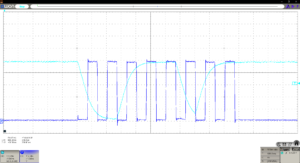A oscilloscope can be used to measure the modulation index of an amplitude modulated wave. Modulation index is a value from 0 to `1, but is often expressed as a percentage.
The discussion here assumes symmetric modulation, it does not apply to super modulation schemes or any other schemes that are asymmetric.
Envelope method
If an oscilloscope is used to display the modulation envelope (as it is known), modulation index can be calculated from measured values of the peak voltage at the crest and valley of the envelope waveform.
Modulation index can be calculated as \(m=\frac{b-a}{b+a}\). Continue reading Measuring modulation index of an amplitude modulated wave with an oscilloscope







